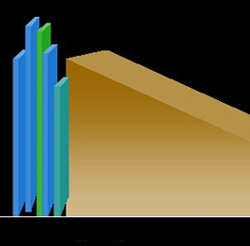
Different Reverb Types
There are two main types of artificial reverb: Synthesized and convolution-based. Synthesized reverb “models” the sound of a room through the use of various algorithms (Fig. 1).
For example, a “Hall” algorithm will take into account that waves travel further in a concert hall than in a small room, so the reverb will take longer to decay. A “Room” algorithm might model a small room, like a club or practice space.
Other algorithms model artificial reverbs, such as “Spring” reverbs found in guitar amps, or “Plate” reverbs that were used extensively in the 60s.
Each algorithm has a different sound quality, but they all work in the same basic way: A signal comes into the reverb, is analyzed, and the reverb algorithm generates echoes and reflections that mimic what happens in the chosen acoustic space.
Convolution reverb is a relatively new type of technology that “samples” the sound of a room.
Typically, a device like a sports starting pistol will create an impulse that creates reflections in a room.
These reflections are recorded, analyzed, and converted into a very accurate model of that specific room.
A good analogy is that a convolution reverb’s impulse is like a “mold” that you pour sound into, and the sound acquires the characteristics of being in that room.
You can think of the difference between synthesized and convolution reverb as the difference between a synthesizer and a sampler.
The synthesizer will give more control over the sound but have a more “impressionistic” character, while a sampler provides an extremely accurate, but generally less editable, sound.
Another consideration is that convolution reverb is a very processor-intensive operation.
Only in recent years have computers become powerful enough to allow for real-time operation, and even then, you might experience some audible delays due to processing.
Fortunately, as reverbs are based on delays anyway, with fast computers you might not notice anything objectionable.
